2009 PORSCHE PANAMERA page 42
[x] Cancel search: page 42Page 47 of 343
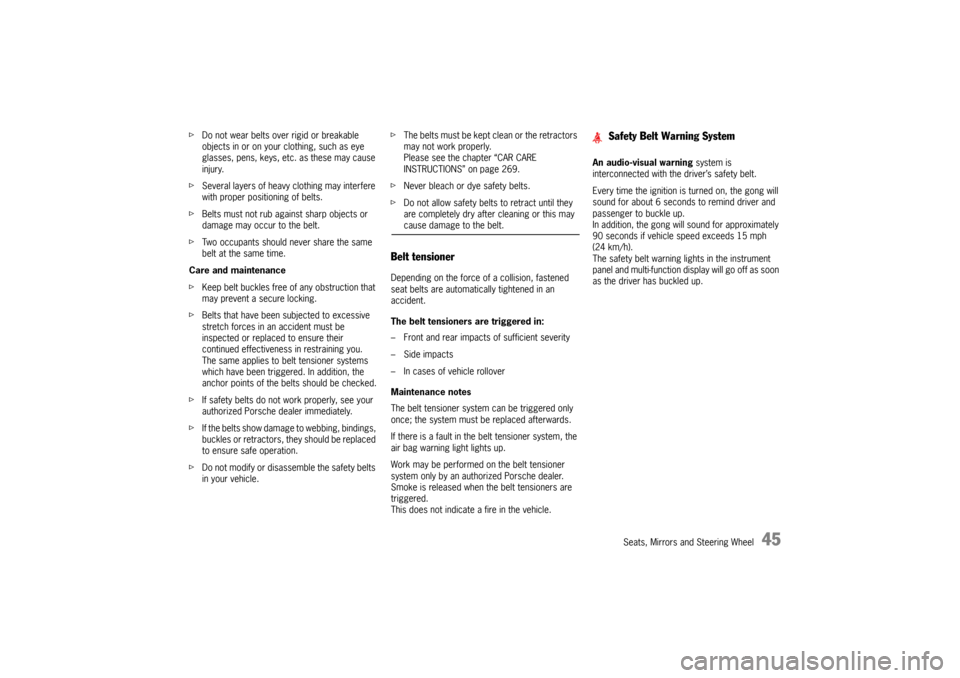
Seats, Mirrors and Steering Wheel
45
fDo not wear belts over rigid or breakable
objects in or on your clothing, such as eye
glasses, pens, keys, etc. as these may cause
injury.
f Several layers of heavy clothing may interfere
with proper positioning of belts.
f Belts must not rub against sharp objects or
damage may occur to the belt.
f Two occupants should never share the same
belt at the same time.
Care and maintenance
f Keep belt buckles free of any obstruction that
may prevent a secure locking.
f Belts that have been subjected to excessive
stretch forces in an accident must be
inspected or replaced to ensure their
continued effectiveness in restraining you.
The same applies to belt tensioner systems
which have been triggered. In addition, the
anchor points of the belts should be checked.
f If safety belts do not work properly, see your
authorized Porsche dealer immediately.
f If the belts show damage to webbing, bindings,
buckles or retractors, they should be replaced
to ensure safe operation.
f Do not modify or disassemble the safety belts
in your vehicle. f
The belts must be kept clean or the retractors
may not work properly.
Please see the chapter “CAR CARE
INSTRUCTIONS” on page 269.
f Never bleach or dye safety belts.
f Do not allow safety belts to retract until they
are completely dry after cleaning or this may
cause damage to the belt.
Belt tensionerDepending on the force of a collision, fastened
seat belts are automatically tightened in an
accident.
The belt tensioners are triggered in:
– Front and rear impacts of sufficient severity
– Side impacts
– In cases of vehicle rollover
Maintenance notes
The belt tensioner system can be triggered only
once; the system must be replaced afterwards.
If there is a fault in the belt tensioner system, the
air bag warning light lights up.
Work may be performed on the belt tensioner
system only by an authorized Porsche dealer.
Smoke is released when the belt tensioners are
triggered.
This does not indicate a fire in the vehicle. An audio-visual warning
system is
interconnected with the driver’s safety belt.
Every time the ignition is turned on, the gong will
sound for about 6 seconds to remind driver and
passenger to buckle up.
In addition, the gong will sound for approximately
90 seconds if vehicle speed exceeds 15 mph
(24 km/h).
The safety belt warning lights in the instrument
panel and multi-function display will go off as soon
as the driver has buckled up.
Safety Belt Warning System
Page 49 of 343
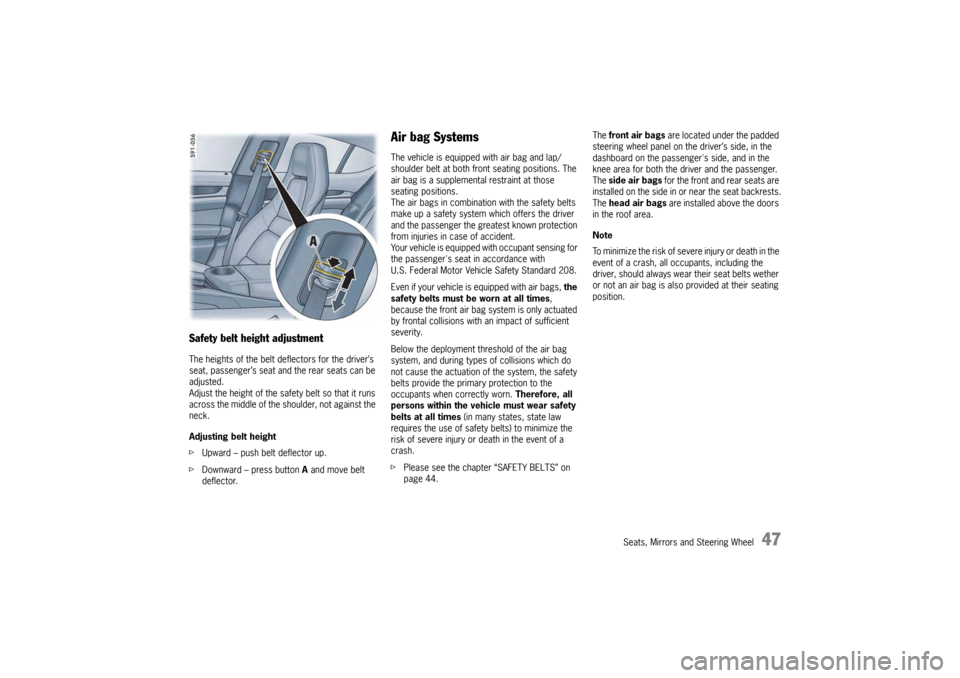
Seats, Mirrors and Steering Wheel
47
Safety belt height adjustmentThe heights of the belt deflectors for the driver’s
seat, passenger’s seat and the rear seats can be
adjusted.
Adjust the height of the safe ty belt so that it runs
across the middle of the shoulder, not against the
neck.
Adjusting belt height
f Upward – push belt deflector up.
f Downward – press button A and move belt
deflector.
Air bag SystemsThe vehicle is equipped with air bag and lap/
shoulder belt at both front seating positions. The
air bag is a supplemental restraint at those
seating positions.
The air bags in combinatio n with the safety belts
make up a safety system which offers the driver
and the passenger the greatest known protection
from injuries in case of accident.
Your vehicle is equipped with occupant sensing for
the passenger's seat in accordance with
U.S. Federal Motor Vehicle Safety Standard 208.
Even if your vehicle is equipped with air bags, the
safety belts must be worn at all times ,
because the front air bag system is only actuated
by frontal collisions with an impact of sufficient
severity.
Below the deployment threshold of the air bag
system, and during types of collisions which do
not cause the actuation of the system, the safety
belts provide the primary protection to the
occupants when correctly worn. Therefore, all
persons within the vehicle must wear safety
belts at all times (in many states, state law
requires the use of safety belts) to minimize the
risk of severe injury or death in the event of a
crash.
f Please see the chapter “SAFETY BELTS” on
page 44. The
front air bags are located under the padded
steering wheel panel on the driver’s side, in the
dashboard on the passenger's side, and in the
knee area for both the driver and the passenger.
The side air bags for the front and rear seats are
installed on the side in or near the seat backrests.
The head air bags are installed above the doors
in the roof area.
Note
To minimize the risk of seve re injury or death in the
event of a crash, all occupants, including the
driver, should always wear their seat belts wether
or not an air bag is also provided at their seating
position.
Page 52 of 343
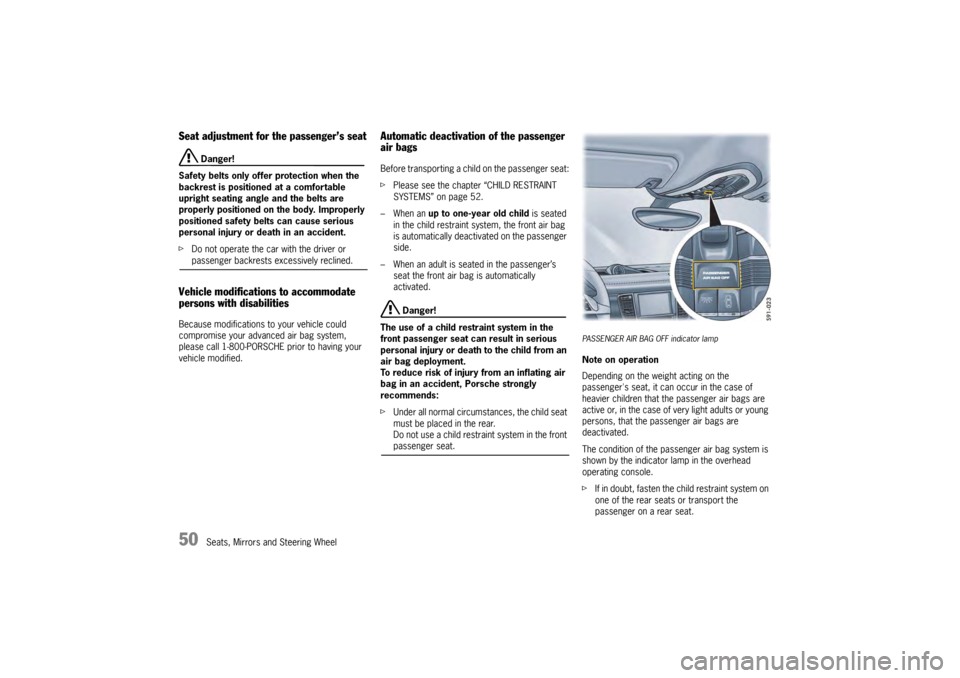
50
Seats, Mirrors and Steering Wheel
Seat adjustment for the passenger’s seat
Danger!
Safety belts only offer protection when the
backrest is positioned at a comfortable
upright seating angle and the belts are
properly positioned on the body. Improperly
positioned safety belts can cause serious
personal injury or death in an accident.
f Do not operate the car with the driver or passenger backrests excessively reclined.
Vehicle modifications to accommodate
persons with disabilitiesBecause modifications to your vehicle could
compromise your advanced air bag system,
please call 1-800-PORSCHE prior to having your
vehicle modified.
Automatic deactivation of the passenger
air bagsBefore transporting a child on the passenger seat:
fPlease see the chapter “CHILD RESTRAINT
SYSTEMS” on page 52.
– When an up to one-year old child is seated
in the child restraint system, the front air bag
is automatically deactivated on the passenger
side.
– When an adult is seated in the passenger’s seat the front air bag is automatically
activated.
Danger!
The use of a child restraint system in the
front passenger seat can result in serious
personal injury or death to the child from an
air bag deployment.
To reduce risk of injury from an inflating air
bag in an accident, Porsche strongly
recommends:
f Under all normal circumstances, the child seat
must be placed in the rear.
Do not use a child restra int system in the front passenger seat.
PASSENGER AIR BAG OFF indicator lampNote on operation
Depending on the weight acting on the
passenger's seat, it can occur in the case of
heavier children that the passenger air bags are
active or, in the case of very light adults or young
persons, that the passenger air bags are
deactivated.
The condition of the passenger air bag system is
shown by the indicator lamp in the overhead
operating console.
f If in doubt, fasten the child restraint system on
one of the rear seats or transport the
passenger on a rear seat.
Page 54 of 343
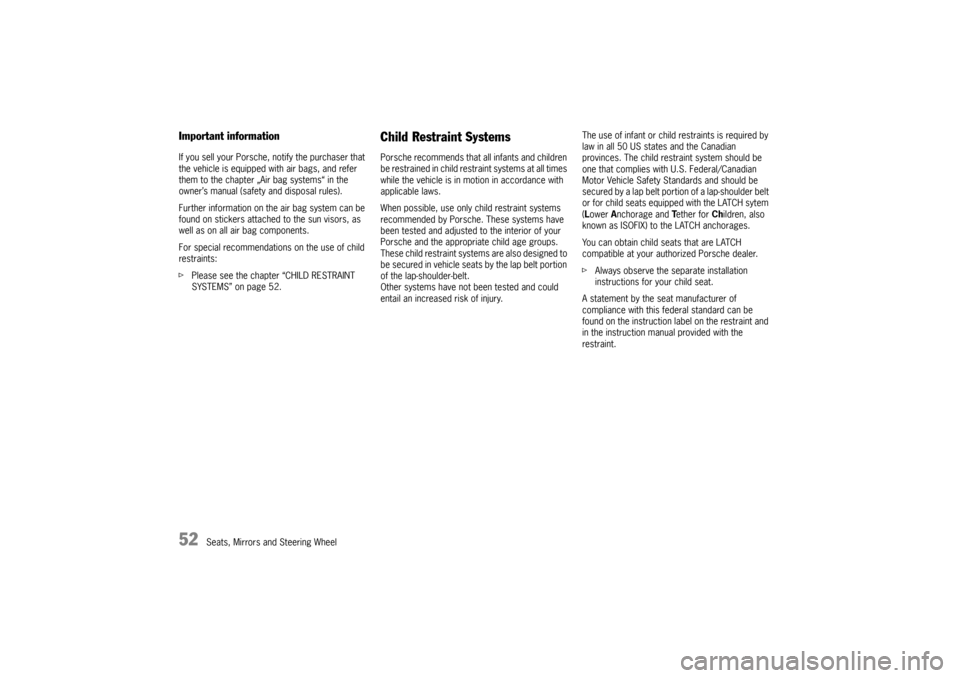
52
Seats, Mirrors and Steering Wheel
Important informationIf you sell your Porsche, notify the purchaser that
the vehicle is equipped with air bags, and refer
them to the chapter „Air bag systems“ in the
owner’s manual (safety and disposal rules).
Further information on the air bag system can be
found on stickers attached to the sun visors, as
well as on all air bag components.
For special recommendations on the use of child
restraints:
f Please see the chapter “CHILD RESTRAINT
SYSTEMS” on page 52.
Child Restraint SystemsPorsche recommends that all infants and children
be restrained in child restraint systems at all times
while the vehicle is in motion in accordance with
applicable laws.
When possible, use only child restraint systems
recommended by Porsche. These systems have
been tested and adjusted to the interior of your
Porsche and the appropriate child age groups.
These child restraint systems are also designed to
be secured in vehicle seats by the lap belt portion
of the lap-shoulder-belt.
Other systems have not been tested and could
entail an increased risk of injury. The use of infant or child restraints is required by
law in all 50 US states and the Canadian
provinces. The child restraint system should be
one that complies with
U.S. Federal/Canadian
Motor Vehicle Safety Standards and should be
secured by a lap belt portio n of a lap-shoulder belt
or for child seats equipped with the LATCH sytem
( L ower A nchorage and Tether for Children, also
known as ISOFIX) to the LATCH anchorages.
You can obtain child seats that are LATCH
compatible at your authorized Porsche dealer.
f Always observe the separate installation
instructions for your child seat.
A statement by the seat manufacturer of
compliance with this federal standard can be
found on the instruction label on the restraint and
in the instruction manua l provided with the
restraint.
Page 57 of 343
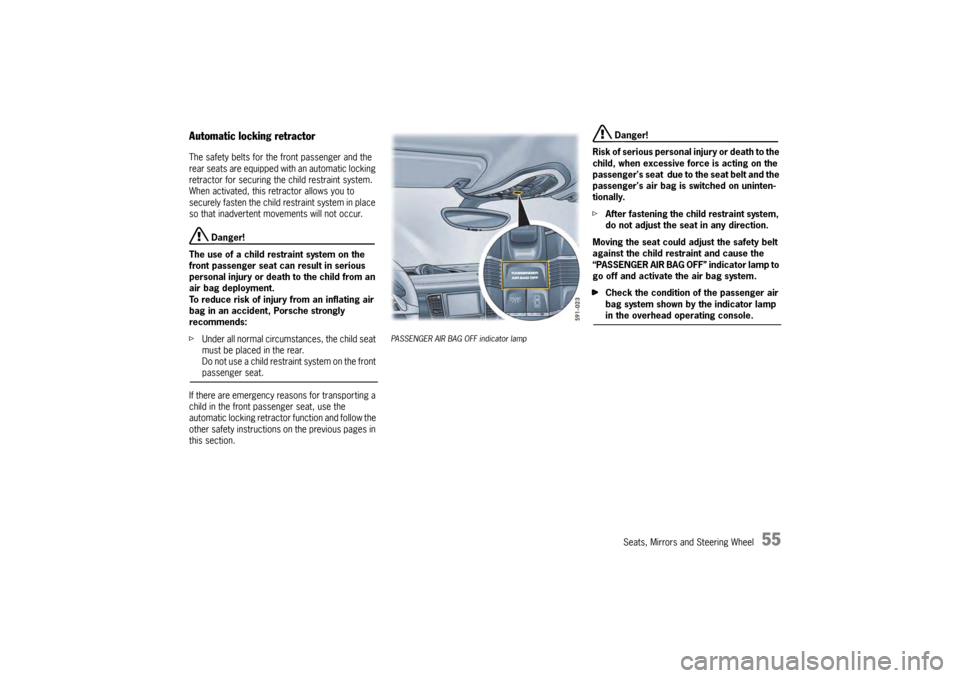
Seats, Mirrors and Steering Wheel
55
Automatic locking retractorThe safety belts for the front passenger and the
rear seats are equipped with an automatic locking
retractor for securing the child restraint system.
When activated, this retractor allows you to
securely fasten the child restraint system in place
so that inadvertent movements will not occur.
Danger!
The use of a child restraint system on the
front passenger seat can result in serious
personal injury or death to the child from an
air bag deployment.
To reduce risk of injury from an inflating air
bag in an accident, Porsche strongly
recommends:
f Under all normal circumstances, the child seat
must be placed in the rear.
Do not use a child restraint system on the front passenger seat.
If there are emergency reasons for transporting a
child in the front pa ssenger seat, use the
automatic locking retracto r function and follow the
other safety instructions on the previous pages in
this section.
PASSENGER AIR BAG OFF indicator lamp
Danger!
Risk of serious personal injury or death to the
child, when excessive force is acting on the
passenger's seat due to the seat belt and the
passenger's air bag is switched on uninten-
tionally.
f After fastening the child restraint system,
do not adjust the seat in any direction.
Moving the seat could adjust the safety belt
against the child restraint and cause the
“PASSENGER AIR BAG OFF” indicator lamp to
go off and activate the air bag system.
f Check the condition of the passenger air
bag system shown by the indicator lamp in the overhead operating console.
Page 59 of 343
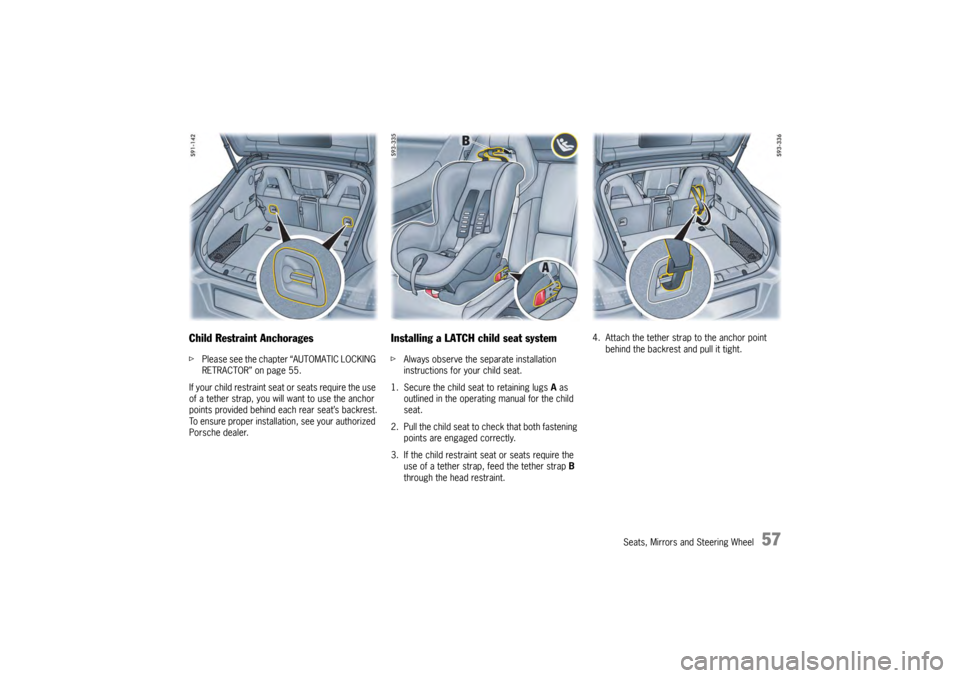
Seats, Mirrors and Steering Wheel
57
Child Restraint AnchoragesfPlease see the chapter “AUTOMATIC LOCKING
RETRACTOR” on page 55.
If your child restraint seat or seats require the use
of a tether strap, you will want to use the anchor
points provided behind each rear seat’s backrest.
To ensure proper installation, see your authorized
Porsche dealer.
Installing a LATCH child seat systemf Always observe the separate installation
instructions for your child seat.
1. Secure the child seat to retaining lugs A as
outlined in the operating manual for the child
seat.
2. Pull the child seat to check that both fastening points are engaged correctly.
3. If the child restraint seat or seats require the use of a tether strap, feed the tether strap B
through the head restraint. 4. Attach the tether strap to the anchor point
behind the backrest and pull it tight.
Page 61 of 343
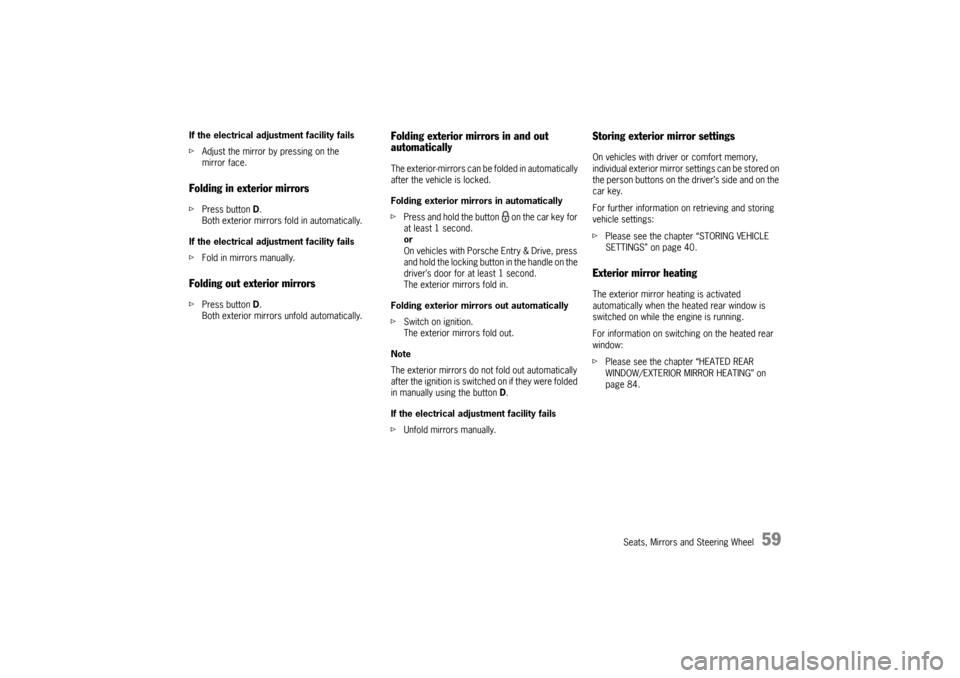
Seats, Mirrors and Steering Wheel
59
If the electrical adjustment facility fails
f Adjust the mirror by pressing on the
mirror face.Folding in exterior mirrorsfPress button D.
Both exterior mirrors fold in automatically.
If the electrical adjustment facility fails
f Fold in mirrors manually.Folding out exterior mirrorsfPress button D.
Both exterior mirrors unfold automatically.
Folding exterior mirrors in and out
automaticallyThe exterior-mirrors can be folded in automatically
after the vehicle is locked.
Folding exterior mirrors in automatically
f Press and hold the button on the car key for
at least 1 second.
or
On vehicles with Porsche Entry & Drive, press
and hold the locking button in the handle on the
driver’s door for at least 1 second.
The exterior mirrors fold in.
Folding exterior mirr ors out automatically
f Switch on ignition.
The exterior mirrors fold out.
Note
The exterior mirrors do not fold out automatically
after the ignition is switch ed on if they were folded
in manually using the button D.
If the electrical adj ustment facility fails
f Unfold mirrors manually.
Storing exterior mirror settingsOn vehicles with driver or comfort memory,
individual exterior mirror settings can be stored on
the person buttons on the driver’s side and on the
car key.
For further information on retrieving and storing
vehicle settings:
f Please see the chapter “STORING VEHICLE
SETTINGS” on page 40.Exterior mirror heatingThe exterior mirror heating is activated
automatically when the heated rear window is
switched on while the engine is running.
For information on switch ing on the heated rear
window:
f Please see the chapter “HEATED REAR
WINDOW/EXTERIOR MIRROR HEATING” on
page 84.
Page 62 of 343

60
Seats, Mirrors and Steering Wheel
Automatic anti-dazzle exterior mirrorThe exterior mirrors change to anti-dazzle
position automatically in synchronisation with
the interior mirror.
For information on the automatic anti-dazzle
function of the interior mirror:
fPlease see the chapter “AUTOMATIC ANTI-
DAZZLE INTERIOR MIRROR” on page 60.Swivelling down mirror glass as
parking aid When reverse gear is engaged, the mirror on the
passenger’s side swivels down slightly to show
the curb area.
f Please see the chapter “SWIVELLING DOWN
MIRROR GLASS AS PARKING AID” on
page 242.
Automatic anti-dazzle interior mirrorSensors on the front and rear sides of the interior
mirror measure the incident light. The mirrors
automatically change to anti-dazzle position or
revert to their normal state, depending on the light
intensity.
Note on operation
The incidental light within the detection area
of the light sensor C must not be restricted
(e.g. by stickers on the rear window or items
of luggage in the luggage compartment). Switching off automatic anti-dazzle function
f
Press button B.
The indicator light A goes out.
Note on operation
The anti-dazzle function switches off
automatically if:
– Reverse gear is engaged or
– Interior lighting is switched on.
Switching on automatic anti-dazzle function
f Press button B.
Indicator light A lights up.
Warning!
Risk of injury. Electrolyte fluid may escape
from broken mirror glass. This fluid irritates
the skin and eyes.
f If the electrolyte fluid sh ould come into contact
with the skin or eyes, rinse it off immediately
with clean water.
Seek medical attention if necessary.
Risk of damage to paintwork, leather, plastic
parts and clothing. Electrolyte fluid can be
removed only while it is still wet.
f Clean the affected parts with water.